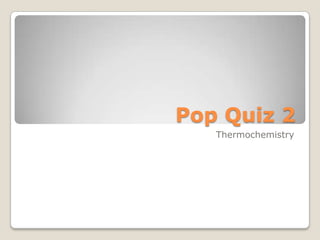Pop quiz 3
•Download as PPTX, PDF•
0 likes•1,180 views
Answers to Thermodynamics Pop Quiz
Report
Share
Report
Share

Recommended
Recommended
More Related Content
What's hot
What's hot (20)
CHM023L - B06 Final Report Group 3 Experiment 3 (Chemical Equilibrium: Le Cha...

CHM023L - B06 Final Report Group 3 Experiment 3 (Chemical Equilibrium: Le Cha...
Similar to Pop quiz 3
Similar to Pop quiz 3 (20)
New chm-152-unit-2-power-points-sp13-140227172047-phpapp01

New chm-152-unit-2-power-points-sp13-140227172047-phpapp01
Heat and thermodynamics - III / Dr. Mathivanan Velumani

Heat and thermodynamics - III / Dr. Mathivanan Velumani
More from Garsh Garcia
More from Garsh Garcia (6)
Recently uploaded
Recently uploaded (20)
HMCS Max Bernays Pre-Deployment Brief (May 2024).pptx

HMCS Max Bernays Pre-Deployment Brief (May 2024).pptx
ICT Role in 21st Century Education & its Challenges.pptx

ICT Role in 21st Century Education & its Challenges.pptx
General Principles of Intellectual Property: Concepts of Intellectual Proper...

General Principles of Intellectual Property: Concepts of Intellectual Proper...
Python Notes for mca i year students osmania university.docx

Python Notes for mca i year students osmania university.docx
Vishram Singh - Textbook of Anatomy Upper Limb and Thorax.. Volume 1 (1).pdf

Vishram Singh - Textbook of Anatomy Upper Limb and Thorax.. Volume 1 (1).pdf
UGC NET Paper 1 Mathematical Reasoning & Aptitude.pdf

UGC NET Paper 1 Mathematical Reasoning & Aptitude.pdf
Kodo Millet PPT made by Ghanshyam bairwa college of Agriculture kumher bhara...

Kodo Millet PPT made by Ghanshyam bairwa college of Agriculture kumher bhara...
ICT role in 21st century education and it's challenges.

ICT role in 21st century education and it's challenges.
Basic Civil Engineering first year Notes- Chapter 4 Building.pptx

Basic Civil Engineering first year Notes- Chapter 4 Building.pptx
Pop quiz 3
- 1. Pop Quiz 2 Thermochemistry
- 2. How does the entropy of the system PbI2(s) + H2O(l) change as PbI2(s) dissolves in water at 25°C? Explain As PbI2 is dissolved in water, the solid PbI2 dissociates into an aqueous solutions of ions containing Pb2+ and I-. The resulting solution has more positional entropy than that of the solid. Hence the entropy of the system increases.
- 3. If the temperature of the system were lowered from 25°C to 15°C, what would be the effect on the value of Ksp? Explain. According to Le Chatelier principle, an endothermic reaction shifts to the left when the temperature is decreased. Hence, the Ksp value will decrease with the lowering of temperature.
- 4. If additional solid PbI2 were added to the system at equilibrium, what would be the effect on the concentration of I¯ in the solution? Explain. According to Le Chatelier principle, adding a solid to a system that is already in equilibrium has no effect on the equilibrium position nor the equilibrium constant of the system. Hence, an additional solid PbI2 would not affect the I- concentration in the solution.
- 5. At equilibrium, delta G = 0. What is the initial effect on the value of delta G of adding a small amount of Pb(NO3)2 to the system at equilibrium? Explain. According to Le Chatelier principle, increasing the concentration of an aqueous product will shift the equilibrium to the left. Adding a soluble Pb(NO3)3 increases the Pb2+ concentration in the solution and the equilibrium will shift to the left. Hence, the value of ∆G will increase or would become more positive.
- 6. Predict the sign of the entropy change, delta S, as the reaction proceeds to the right. Explain your prediction. As the reaction proceeds to the right, the gaseous reactants are converted to a solid product. Gaseous molecules have more positional entropy than that of the solid molecules. The solid product is less random than that of the gaseous reactants. Hence, the entropy change would be negative.
- 7. If the reaction spontaneously proceeds to the right, predict the sign of the enthalpy change, delta H. Explain your prediction. If the reaction proceeds spontaneously to the right, then the value of ∆G must be (-). The sign of ∆S is also (-). Using ∆G=∆H - T∆S, ∆H must be a negative value and bigger than T∆S to make the value of ∆G negative as well.
- 8. The direction in which the reaction spontaneously proceeds changes as the temperature is increased above a specific temperature. Explain. The reaction is enthalpy-driven. The value of ∆H > T∆S to maintain the spontaneity of the reaction. At lower temperatures, T < (∆H /∆S ) the reaction is spontaneous. Above this temperature, the reaction becomes non spontaneous.
- 9. What is the value of the equilibrium constant at the temperature referred to in (c); that is, the specific temperature at which the direction of the spontaneous reaction changes? Explain. At equilibirium ∆G = 0, hence ∆Go = - RTlnK. The temperature referred to in part c where the spontaneity of the reaction changes, happens when ∆Go =0 as well. Hence K=1.
